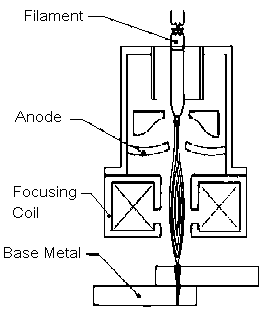Electron Beam Welding
Electron Beam Welding (EBW) is a fusion joining process that produces a weld by impinging a beam of high energy electrons to heat the weld joint. Electrons are elementary atomic particles characterized by a negative charge and an extremely small mass. Raising electrons to a high energy state by accelerating them to roughly 30 to 70 percent of the speed of light provides the energy to heat the weld.
An EBW gun functions similarly to a TV picture tube. The major difference is that a TV picture tube continuously scans the surface of a luminescent screen using a low intensity electron beam to produce a picture. An EBW gun uses a high intensity electron beam to target a weld joint. The weld joint converts the electron beam to the heat input required to make a fusion weld.
The electron beam is always generated in a high vacuum. The use of specially designed orifices separating a series of chambers at various levels of vacuum permits welding in medium and nonvacuum conditions. Although, high vacuum welding will provide maximum purity and high depth to width ratio welds.
EBW Benefits
EBW Limitations
| |
Common EBW Concerns
We can help optimize your welding process variables. Evaluate your current welding parameters and techniques. Help eliminate common welding problems and discontinuities such as those listed below:
EBW Problems and Discontinuities
-
Undercutting
-
Porosity
-
Cracking
-
Underfill
-
Lack of fusion
-
Shrinkage voids
-
Missed joints


No comments:
Post a Comment